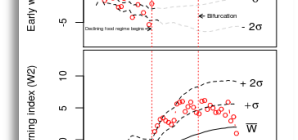
Background. Theory predicts that extinction rates should be lower in constant environments than in randomly fluctuating environments with the same average conditions. This is because…

It is well understood that natural populations do not necessarily reflect the assumption of a homogeneous well-mixed population assumed by most of theories of population…

Background. Population persistence is predicted by theory to increase with carrying capacity and a population’s capacity to increase rapidly. We view both carrying capacity and…

Background A partial differential equation model of population growth and dispersal developed by Lewis and Karieva (1993) predicts that invading populations subject to an…

Above – A composite early warning index comprising all four indicators is highly sensitive to the onset of critical slowing down. a, Time-specific calculations of…

One of the interesting things about the theory of population extinction is that despite widely differing processes for the cause of extinction (demographic stochasticity, environmental…

Another approach we take towards understanding the Allee effect is to look for statistical “signatures” in population dynamics, i.e., patterns in population abundance or distribution…

Background A partial differential equation model of population growth and dispersal developed by Lewis and Karieva (1993) predicts that invading populations subject to an Allee…

Background. Recent studies on animal populations in the field have attributed positive-density dependence at low density to a predator-driven Allee effect (e.g. Wittmer et al….





